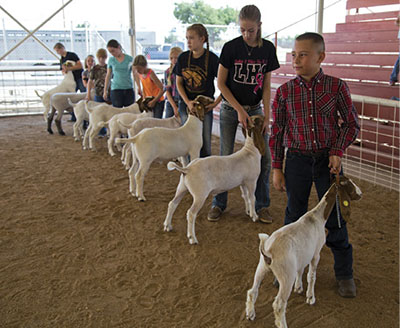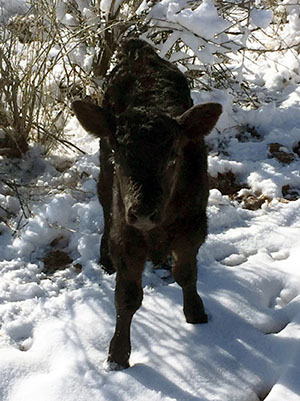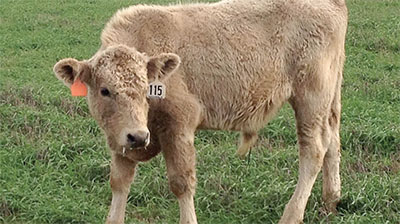Guide B-131
Marcy Ward, John Wenzel, and Steve Lucero
College of Agricultural, Consumer and Environmental Sciences, New Mexico State University
Authors: Respectively, Extension Livestock Specialist, Department of Extension Animal Sciences and Natural Resources (ASNR); Extension Veterinarian, ASNR; and County Program Director/Extension 4-H and Agriculture Agent, Sandoval County Extension Office, New Mexico State University. (Print Friendly PDF)
Introduction
Biosecurity can be defined as procedures designed to protect humans and animals from disease or harmful biological agents. When people think of biosecurity, they often assume it only applies to large livestock operations. Even though youth livestock projects are on a smaller scale, these animals can experience the same health risks as those in larger facilities. These animals may come from next door or from another state. Regardless of where they come from, steps should be taken before, during, and after these animals are housed at your home place to help ensure optimal health and performance. The purpose of this publication is to offer guidelines on how to accomplish these tasks.
When an animal gets sick, it can impact their performance in the long term. For example, research has shown that when beef cattle are first treated for respiratory disease, their feed efficiency drops and gains can be reduced by as much as 2 lb per day (Johnson and Pendell, 2017). Sickness can also cause permanent negative effects on carcass quality and carcass weight (Brooks et al., 2011). Therefore, it is important to take practical measures to reduce the risk of sickness in your livestock projects.
Purchasing a Healthy Animal
The initial cost of livestock projects continues to increase. There are many things to consider before making this investment to reduce your animal’s risk of death loss, sickness, or loss in production. Reputable breeders do not intend on selling unhealthy animals. However, the reality is that any animal has the potential to become sick. That risk can be reduced if certain questions are answered and observations are made before the animal is purchased.
Examples of questions to ask before purchasing an animal:
- What vaccines has the animal been given?
- When was the last vaccine given?
- Has the animal ever been treated for sickness?
- When was the animal weaned?
- Has the animal been on pasture or hand fed?
- What has the animal been fed?
Observations that should be noted before purchasing an animal:
- Is the animal alert? Not scared, but interacts with the other animals, demonstrates good energy.
- Eyes and nose are clear.
- Good hair coat with decent shine in cattle, sheep, goats, and horses.
- Normal breathing.
- Sound with no signs of lameness.
Before a New Animal Arrives
There are several tasks that should be done before new animals arrive at your home place. These steps not only help sanitize your facility but also help you get organized and ready for your animal project(s).
- Make sure the feed storage area is clean and dry.
- Take measures to prevent or reduce rodent infestation.
- Prepare an isolation pen that is at least 14 feet from the rest of the livestock.
- Clean and disinfect feed pans and water tanks.
- Take measures to minimize dust and exposure to extreme weather.
- Check with your veterinarian for any vaccinations or other preventive health measures needed upon arrival.
It is important to attend a meat quality assurance training to become familiar with best management practices. These trainings are designed to educate livestock producers about how good management ensures the safety and wholesomeness of the product from their project animals. Trainings can be found through your local county Extension agent (https://aces.nmsu.edu/county/) or online.
Quarantine
It is strongly recommended that new animals be monitored for sickness two to three weeks prior to introducing them to the rest of the livestock at your facility. Most illnesses will present themselves within that time frame. If an animal is a safe distance away from the others, the risk of spreading disease is greatly reduced.
Always feed and water quarantined animals AFTER feeding the other livestock. This will prevent potential viral/bacterial carryover in feed, water, or clothing. Clean all feed pans and water tanks/buckets on a regular basis to reduce disease-causing pathogens.
At the Show
This is the most challenging time for keeping your animals healthy. Most animals are housed with nose-to-nose (exposure to) contact access with other livestock. Additionally, they are under stress, which compromises their immune system and reduces feed and water intake, contributing to potential health issues as well. There are several management techniques that can help reduce the chance of your animals getting sick.
Animals tend to be very sensitive to changes in water supply. Water intake is directly proportional to feed intake. When an animal reduces water intake, it will also reduce feed intake; therefore, water should be the first priority. There are several methods that can help promote water and feed intake and minimize stress:
- Bring some water from home, and blend it with show facility water until water intake is normal.
- Add sweetener/electrolyte drink at home for a few days before the show. Let the animals get accustomed to it, then add the same drink to the show facility water source.
- Add 2 tablespoons of loose salt to cattle feed (1 teaspoon to sheep/goat/hog/horse feed). It should be noted that salt is sometimes used as a feed intake limiter. If the animal starts to back off its feed, simply reduce the amount of loose salt added to the ration.
- The goal is to maximize water intake and prevent dehydration. This can be accomplished by free choice water or by proper drenching. Because most shows and fairs take place in the heat of the summer, heat stress is a common health problem. Water and good ventilation are the only ways to reduce this risk.
- Mix enough feed in advance to make it through the show. Changes in diet—however slight—can also result in animals either going off feed completely or can cause digestive upset.
- Keep your stalls clean and try to minimize dust in their immediate area. Dampen fresh bedding with water, or utilize rubber mats. This will help minimize dust and keep animals clean and dry. Be sure to follow show pen requirements.
The best way to minimize stress is to work with your animal often. Put them in the trailer and haul them several times before taking them to a show. This will help reduce the stress of trailering because they will be used to it. For cattle, this method is an old trick of the trade for halter breaking and teaching cattle to stand tied. Confine them at home several times as they would be at the show. Recreating the show experience will help them acclimate to their new routine more quickly. The more you handle your animal through halter breaking, exercise, or showmanship practice, the calmer and less stressed they should be at the show.
When Your Animals Return from a Show
Clean and disinfect any halters, brushes, combs, feed pans, and water buckets thoroughly with soapy water. Bacteria and some viruses can remain viable for days or even weeks after being brought home from a show or sale auction. You may want to thoroughly clean the stock trailer as an added precaution.
When your animals return, quarantine them away from any other livestock again. If they picked up a disease while at the show, physical separation from the other animals will reduce the spread of disease. Again, signs of sickness may not appear until up to 14 days after exposure.
Signs of Sickness
All species of livestock show similar signs of sickness.
- Changes in behavior
- Lethargic
- Droopy ears
- Reduced feed and water intake
- Isolation
- Visual signs
- Runny nose/eyes
- Labored breathing
- Sometimes diarrhea
- Drawn up/gaunt/sunken appearance
Managing a Sick Animal
All animals have the potential to contract disease. Being prepared and observant can reduce the length of time the animal is sick and how much medication would be required. Consult with your veterinarian BEFORE you receive your animals so that you can have an established plan of action for treating any animals that become ill. Once a change in behavior is noticed, typical health management would include:
- Take the animal’s temperature rectally.
- All animals have a “treatment fever threshold” (Table 1).
- Fever alone should not be the deciding factor. If the animal looks and acts sick, it likely needs some help for recovery.
- Have a clean, dry place that is well ventilated to house the animal.
- You may need to isolate the animal for its protection and to reduce the spread of the sickness to others.
- For cattle, sheep, and goats, provide free choice good-quality, long-stem grass hay along with some of their ration. This helps keep the rumen healthy.
- Depending on the ailment, feed management for horses may vary. Good-quality hay is key for a horse’s digestive health. Consult with your veterinarian on diet management.
- Provide ample clean, fresh water. Treat water with electrolytes or provide them orally to help maintain hydration and gut health.
|
Table 1. Body Temperature Ranges in Livestock |
||
|
Species |
Normal body |
Treatment fever threshold (°F) |
|
Cattle |
101–102.5 |
104+ |
|
Sheep |
101–103 |
104+ |
|
Goat |
102–103 |
104+ |
|
Swine |
101–102.5 |
104+ |
|
Horse |
99–101 |
102+ |
Always Follow Ethical and Legal Guidelines with Your Project Animals
It is very important that all medications be given under the direction of your veterinarian. Many medications, such as antimicrobials, have strict label requirements. You should never give a prohibited or illegal medication to your project animal. Talk to your veterinarian about extra-label drug use. It will be your responsibility when drugs are used against FDA regulations. For example, certain medications (such as Baytril) are prohibited, and are therefore illegal, for extra-label usage in swine, sheep, or goats.
There are appropriate and effective medications for all livestock species. Become familiar with and only utilize those that are appropriate for those species. Check labels and observe proper withdrawal times for all medications, dewormers, and additives given to your project animals. Remember, it is your responsibility for your project animal to be a safe and wholesome product when it is sold, so always observe quality assurance guidelines.
Fly and Mosquito Control
Biting flies and mosquitos have the potential to spread disease through blood transfer. Flies in particular can also dramatically reduce animal performance. A consistent and effective fly control program has been proven to improve average daily gain in calves (Smythe et al., 2019). Fly control can be accomplished through consistent removal of manure, topical applications of fly control products, insecticidal ear tags, or treated rubbing tubes. Premise fly control is also recommended. Utilizing approved permethrins or fly traps can help reduce area fly populations.
Horses are the most susceptible to catching disease from mosquitos. Good vaccination programs and sanitary practices can help reduce the impacts of mosquitos. Consult your veterinarian to help establish an appropriate and consistent vaccination protocol for your horses.
Water sources are the primary breeding grounds for mosquitos. Unfortunately, water tanks can contribute to mosquito populations. Cleaning and scrubbing water tubs and tanks on a regular basis can help with mosquito management.
Regional Disease Outbreak
As a producer, it is your responsibility to be vigilant of disease potential in your local area or the area you may be traveling to for a show. As an example, vesicular stomatitis (VS) outbreaks in horses have affected many county fairs and other exhibitions. Many restrictions, quarantines, and inspections have had to be enforced in order to confine the spread of VS and allow the shows to go on. Be informed—visit with your local veterinarian or your county Extension agent about potential animal health issues. Your state veterinarian’s office is also a good source of information. The state veterinarian will be involved in regulation and management of the disease in question.
After the Animals Leave Your Home Place
Strip clean and disinfect the pens, wash area, feed pans, and water tanks. Stripping requires complete removal of all manure, shavings, urine, and litter that remains. It is a good practice to treat the bare ground with lye. Soap and water are sufficient when cleaning feed pans. Spraying water tanks with bleach can help kill algae, larvae, or bacteria that may be left behind. Leave the dry tanks in the sun for at least a day (sunlight can also help in the sterilization process). Then thoroughly rinse the bleach out of the tank.
Summary
Buying healthy animals from reputable breeders is the first defense in preventing sickness in your 4-H livestock. Get to know the breeder and their health management protocols. Don’t be afraid to ask if the animal has been vaccinated and for what, and also ask if the animal had been previously sick. A good breeder will be glad to provide that information.
If you buy an animal at an auction, the risk of your animal becoming sick increases. This is because an auction sale is the same environment as a show—many animals, often from different farms or ranches, are placed together in a confined space. The combination of comingling and stress always increases an animal’s chance of getting sick. Quality animals can be found at club sale auctions, but they can still contract something foreign to them in the short time they are at the auction location.
There is evidence of the need for improved biosecurity practices among 4-H youth (Smith et al., 2014). 4-H youth and their families make significant monetary investments in animal projects. Thus, applying biosecurity practices may reduce potential financial risks, reduce potential death loss, or cut medical costs. The breeding livestock and horse projects are usually year-round projects. The information provided in this publication also applies.
Whether buying local or from a distance, privately or at an auction, consistent health management and facility care at your home place can help prevent your valued 4-H animals from getting sick. Being vigilant and implementing biosecurity practices are critical for success in a 4-H animal project.
References
Brooks, K.R., K.C. Raper, C.E. Ward, B.P. Holland, C.R. Krehbiel, and D.L. Step. 2011. Economic effects of bovine respiratory disease on feedlot cattle during backgrounding and finishing phases. Journal of Applied Animal Science, 27, 195–203.
Johnson, K.K., and D.L. Pendell. 2017. Market impacts of reducing the prevalence of bovine respiratory disease in United States beef cattle feedlots. Frontiers in Veterinary Science, 4(189), 1–9.
Smith, M.H., C.L. Meechan, and J.A. Borda. 2014. Bio-security proficiencies project for beginning producers in 4-H. Journal of Extension, 52(6), Article 6FEA5. Available at https://www.joe.org/joe/2014december/a5.php
Smythe, B.A., M.E. Wise, A.F. Cibils, D. Vanleeuwen, A.F. Summers, M.G. Fletcher, and E.J. Scholljegerdes. 2019. Growth and reproduction performance of rangeland beef-cattle as influenced by controlled and uncontrolled populations of horn flies (Diptera: Muscidae). Journal of Economic Entomology, 112, 969–973.
For Further Reading
B-715: Are You Ready to Own a Horse? Basic Essentials of Equine Ownership
https://pubs.nmsu.edu/_b/B715/index.html
M-112: Water Quality for Livestock and Poultry
https://pubs.nmsu.edu/_m/M112/index.html
CR-703: Sheep Production: Birth to Weaning
https://pubs.nmsu.edu/_circulars/CR703/index.html

Marcy Ward is the Extension Livestock Specialist at NMSU. She received her B.S. and M.S. in animal science from Colorado State University and NMSU, respectively, and her Ph.D. in ruminant nutrition from North Dakota State University. She was most recently the Beef Program Director at ColbyCommunity College in Colby, KS.
To find more resources for your business, home, or family, visit the College of Agricultural, Consumer and Environmental Sciences on the World Wide Web at pubs.nmsu.edu.
Contents of publications may be freely reproduced, with an appropriate citation, for educational purposes. All other rights reserved. For permission to use publications for other purposes, contact pubs@nmsu.edu or the authors listed on the publication.
New Mexico State University is an equal opportunity/affirmative action employer and educator. NMSU and the U.S. Department of Agriculture cooperating.
July 2022 Las Cruces, NM





